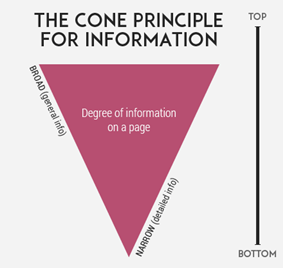
There are two essential components involved in technical writing – the author and the audience. While much emphasis is put on the audience, it is just as important that the writer is equipped with the tools and skills to successfully craft a technical document. Technical documents have no value to the audience if the writer does not have a solid grasp of the topic. Continue reading for strategies that will help technical writers tackle any concept systematically and write better documentation.
The Cone Principle
The Cone Principle organizes information from “broad” (general) to “narrow” (specific). Express Writers’ article “5 Blogging Tips for Technical Writers to Help You Explain High-Tech Topics to Your Audience” provides this example of what the Cone Principle looks like:
 The broad concepts are those that you and your audience already understand. The narrow concepts are more specific and advanced. To gage your knowledge, start with broad concepts and work your way down until you can no longer explain your topic. This strategy is helpful for initial research or if you are writing about a topic that you are unfamiliar with.
The broad concepts are those that you and your audience already understand. The narrow concepts are more specific and advanced. To gage your knowledge, start with broad concepts and work your way down until you can no longer explain your topic. This strategy is helpful for initial research or if you are writing about a topic that you are unfamiliar with.
ADEPT Approach
The Adept approach was developed by Kalid Azad, a maths educator as a way to make it easier to learn difficult concepts, but it works in writing as well. ADEPT stands for Analogy, Diagram, Example, Plain English, and Technical Definition. Each of these categories help writers break down a concept in various ways. The Analogy step entails explaining the concept in comparison to something else. The Diagram steps asks you to draw the concept. For the Example step, think of a scenario or example involving your topic. The Plain English step requires you to explain your concept in the simplest way possible. Lastly, for the Technical Definition step, write down any important details about your topic.
The ADEPT Approach is a great strategy for when you have writer’s block or are having trouble understanding a concept. According to the University of New South Wales’ (UNSW) article “Five tips to learn complex topics,” this technique helps you learn concepts faster because it requires you to explain them in various ways.
The Feynman Technique
According to UNSW, the Feynman Technique, developed by Richard Feynman, is comprised of four steps. All four steps are connected to one another, so it is important to complete each step before moving on to the next one. The four steps are: identify the subject, explain the content, identify your knowledge gaps, simplify your explanation.
Here’s how it works: The first step is to write down a basic explanation of your concept. When doing this, do not conduct supplementary research and avoid using technical terminology. Instead, go off of what you already know. This step allows you to focus on the most essential aspects of your concept. The second step entails revisiting the parts of step one that you had difficultly explaining. With an emphasis on what you need to review, repeat step one (writing down an explanation) until you understand your topic. The third step is figure out what you don’t know and then learn about it. Finally, write down an even simpler explanation. The challenge is to write down your concept both as simply and as thoroughly as possible. Ask yourself how you would explain your topic to your next-door neighbor. If you can complete all the steps, then you have a good grasp of your topic and will write it in a way that the reader can understand.
Conclusion
The most important foundation for any technical document is your understanding of the relevant topic. Use various strategies, such as the Cone Principle, the ADEPT Approach, and the Feynman Technique to break down concepts. These three strategies will help you understand technical topics and improve your writing, whether you are familiar with a topic or tackling it for the first time.
Our writers excel at turning complicated concepts into easy-to-understand tidbits of information. Want to know more? Contact MATC Group today!
Related Blogs
Why Outsource Technical Writing?
Revolutionize the Way you use Images in Technical Documents
Strategies for Simplifying Complex Topics
Resources
“Five tips to learn complex concepts.” University of New South Wales, Sydney. 1/22/20. https://studyonline.unsw.edu.au/blog/tips-learn-complex-concepts



